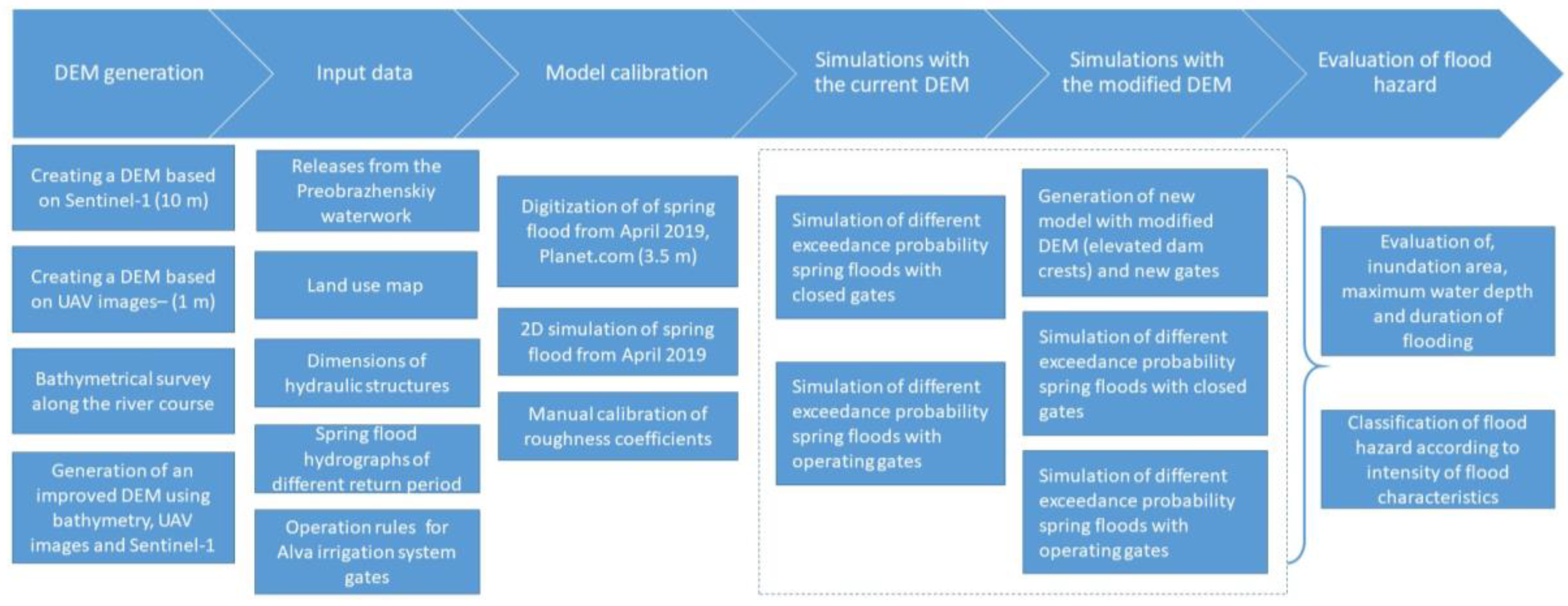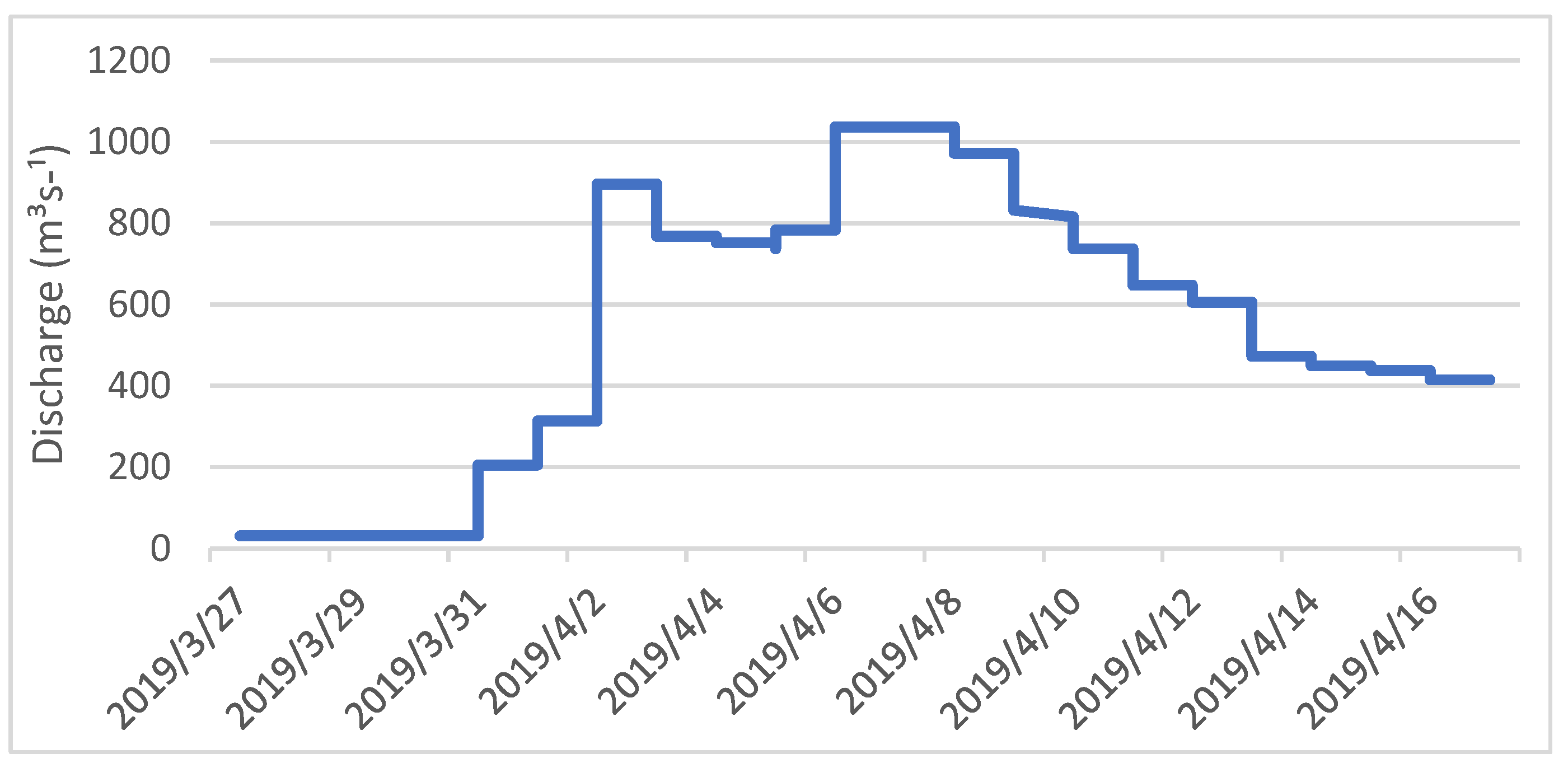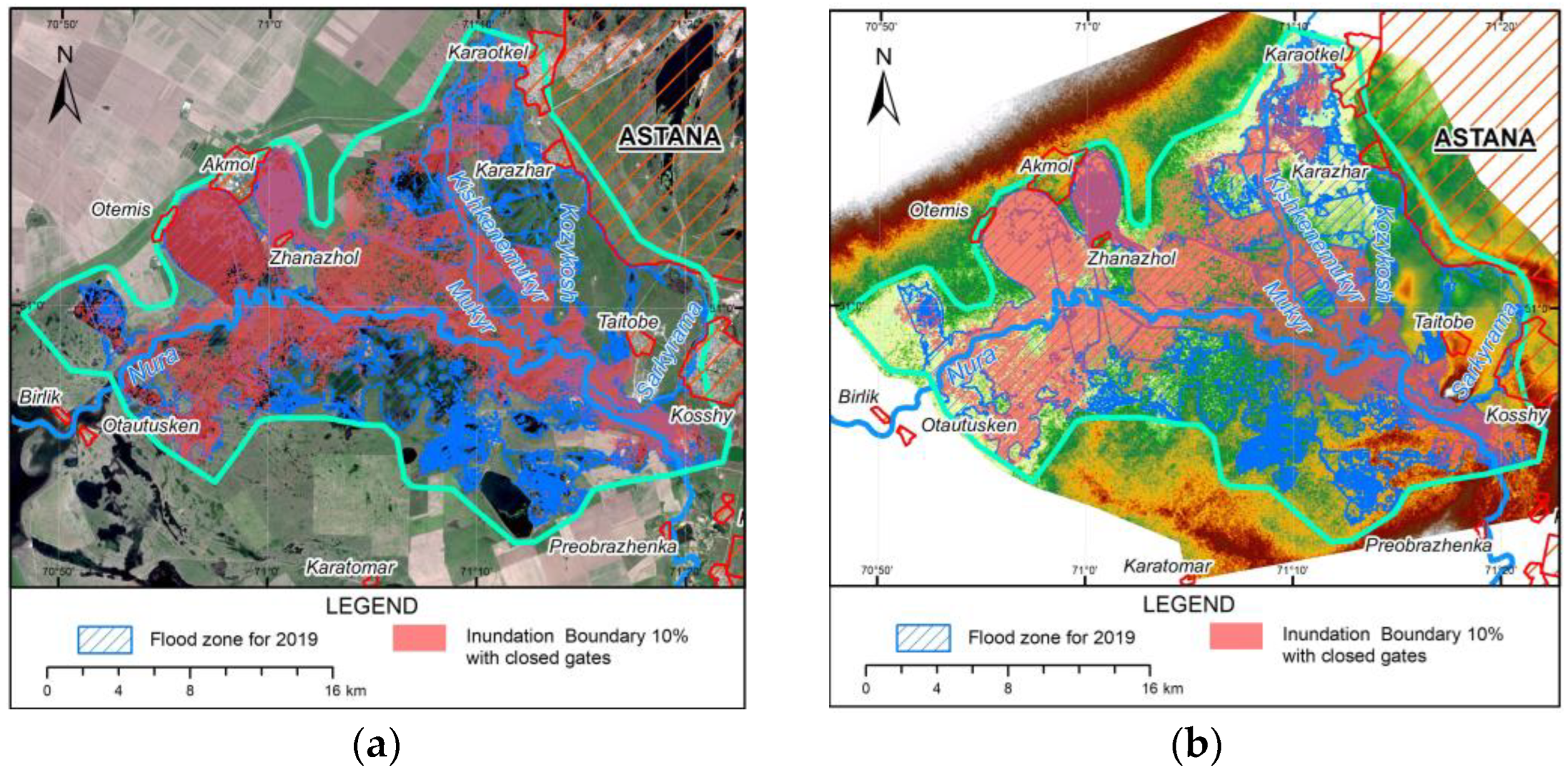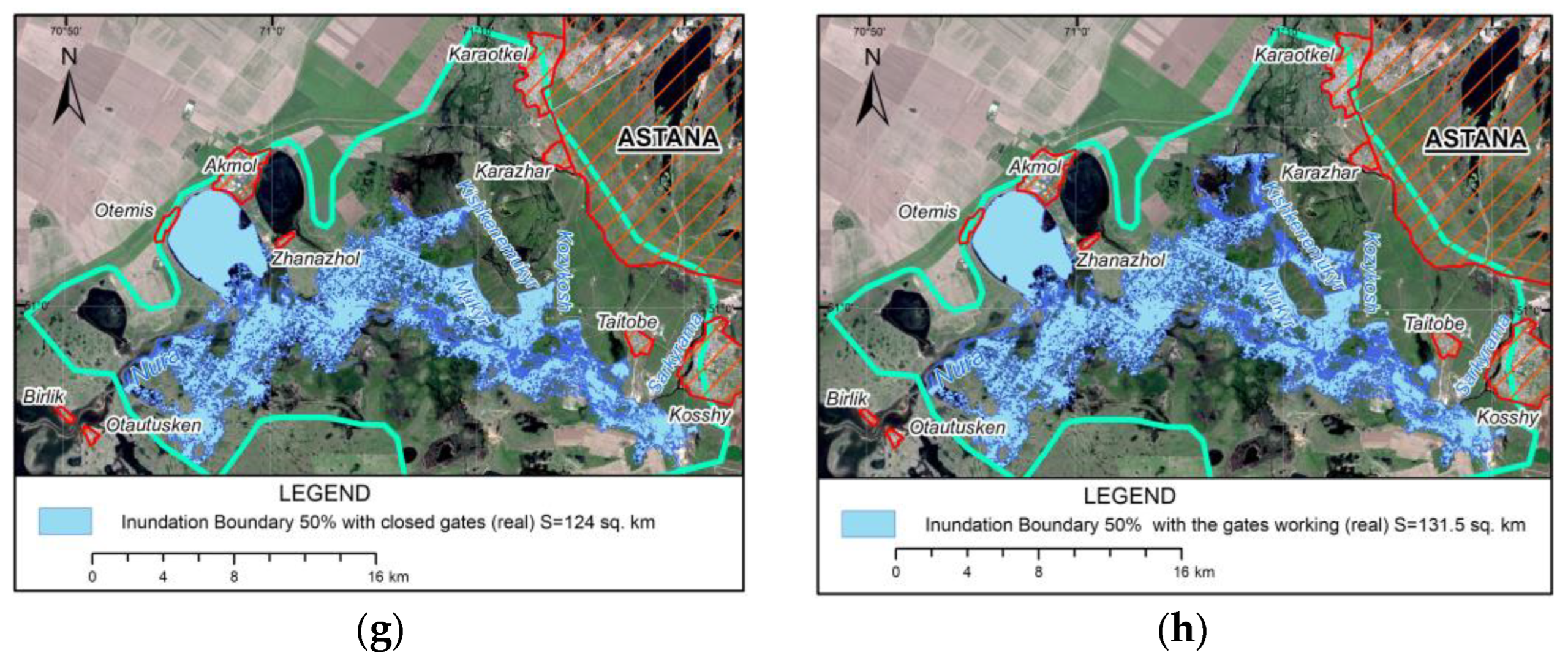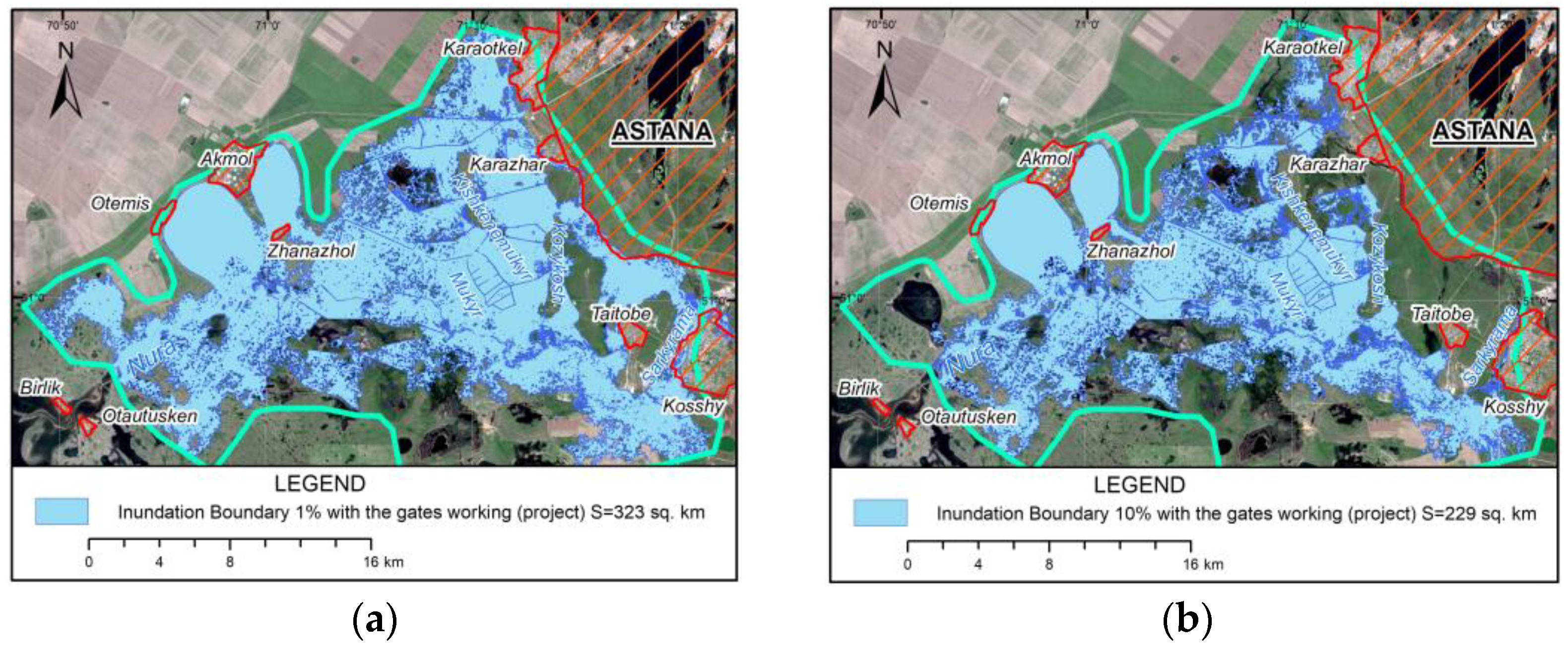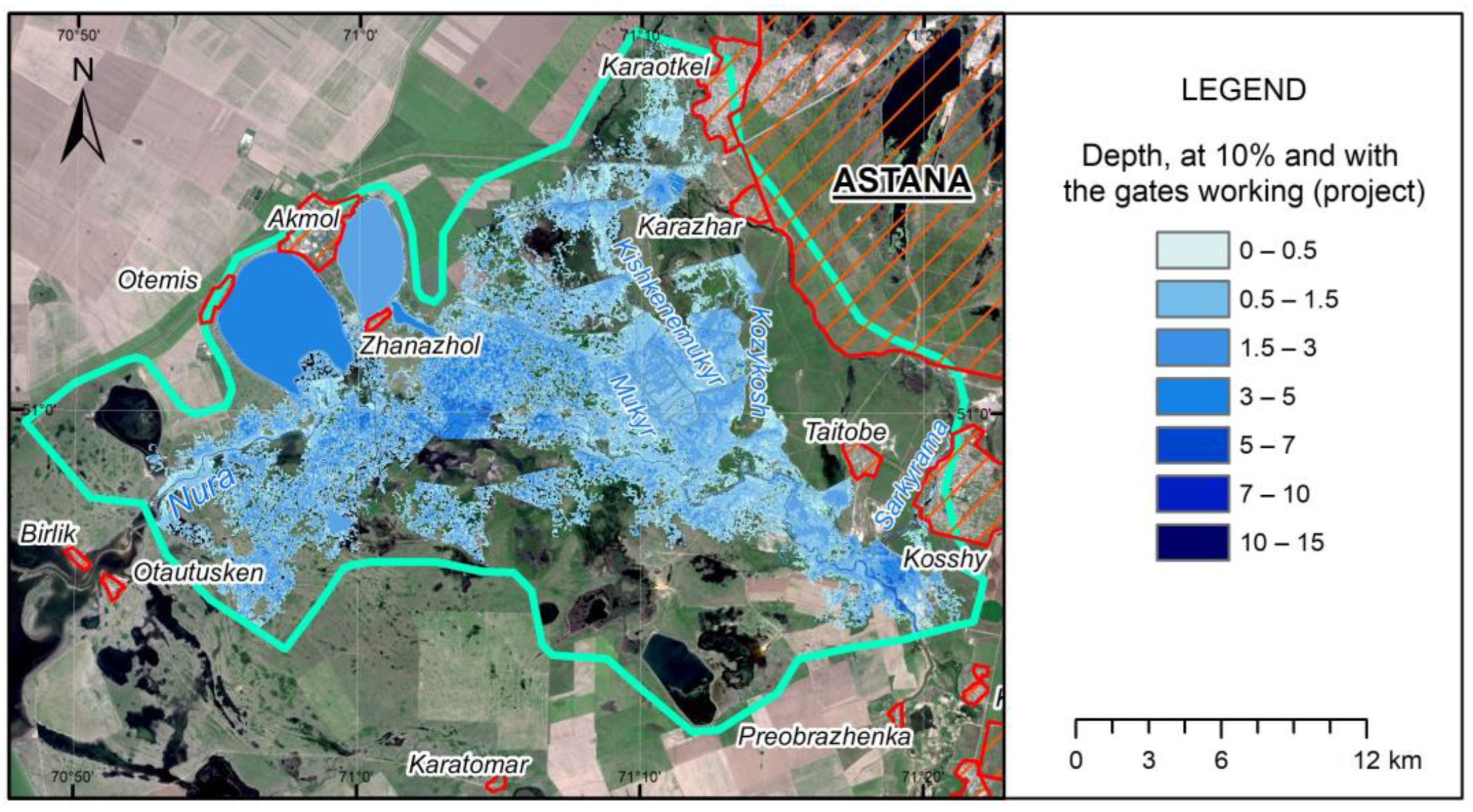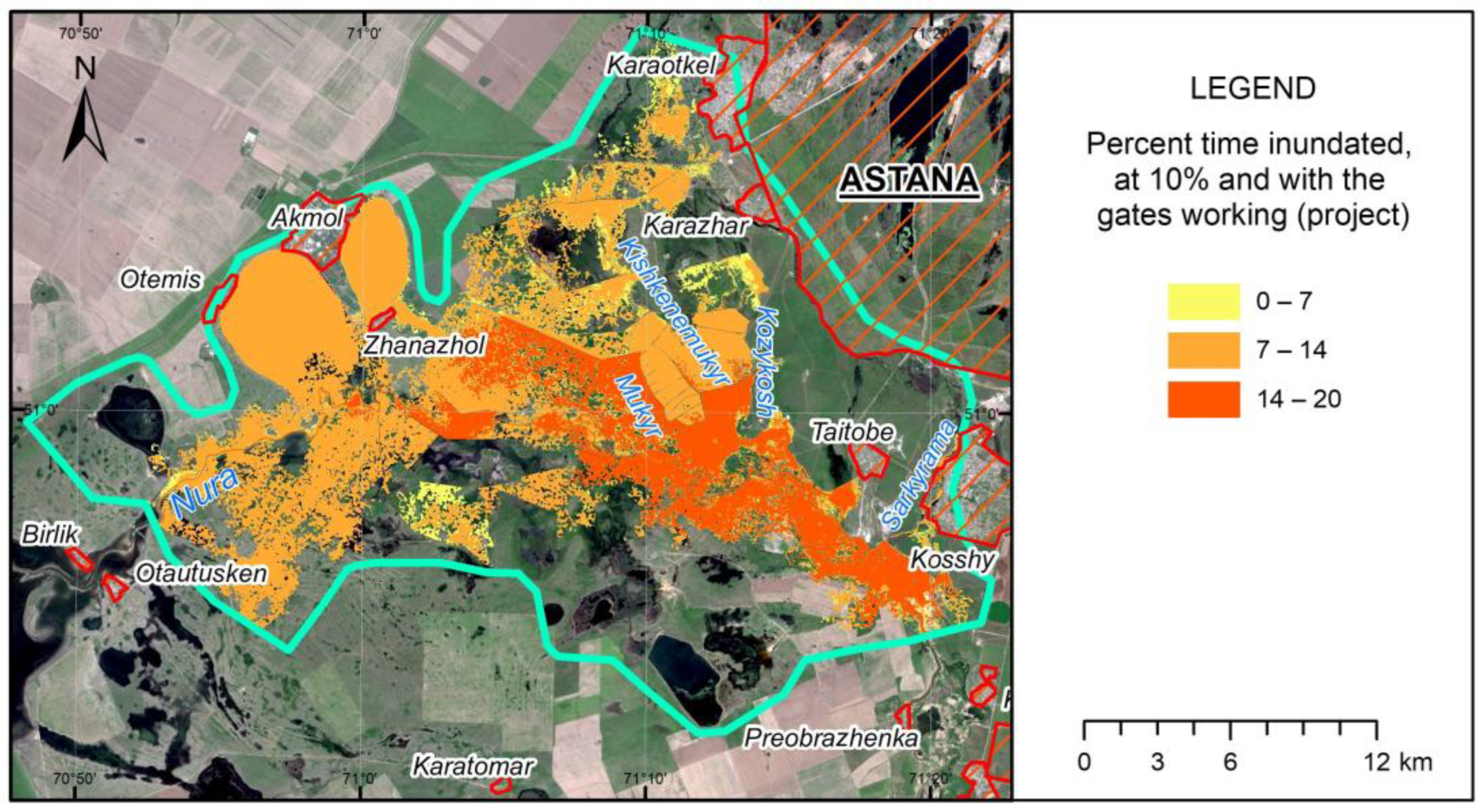1. Introduction
Riverine floods are one of the destructive and complex natural phenomena that are accompanied by significant negative social, economic and environmental consequences [
1]. It has been estimated that floods account for one third of all geophysical hazards in the world [
2]. According to Shahabi et al., Haltas et al. and Tellman et al. [
3,
4,
5], extreme weather conditions, rapid urbanization, growing floodplain settlements, poor watershed management and inadequate response to natural disasters are the main causes of rising flood-event-related losses. Huang et al. [
6] state that the mechanisms of flooding have become more complicated under anthropogenic influence and climate change. These conclusions are confirmed by the catastrophic floods that swept Germany, Belgium, Switzerland and the Netherlands in summer 2021, and the risks associated with these events are predicted to increase in the future due to several reasons, such as climate change, anthropogenic modifications of landscapes and other socio-economic factors [
7]. The Republic of Kazakhstan is in the flood-affected countries list, with 1010 settlements having flood risk [
8]. This natural hazard presents an annual pattern, and the highest risk is caused by spring snowmelt. In the last 15 years, there have been more than 300 floods in Kazakhstan, more than two thirds of which were caused by spring snowmelt [
9]. The recent flooding events during spring snowmelt have mainly affected Aktobe and West Kazakhstan Regions, causing hundreds of people to evacuate and financial losses in the state budget. However, as the news from Turkestan Region in spring 2022 illustrates, pluvial floods can also cause significant flood risk to some settlements. Flooding is also a problem for the capital city Astana and the settlements in its suburban zone. The most active population growth in the country and construction of facilities in the floodplains of Nura and Yesil Rivers have significantly increased the flood risk. Water resources of these rivers are the major source for coping with intensive growth of the city. The research area is located on the interfluve of two large rivers, Nura and Yesil, within the suburban zone of Astana. A complex of natural (topographic, climatic and hydrological conditions) and anthropogenic (regulation regime for hydraulic structures, the state of protective structures) factors result in a flood hazard here [
10]. Among the different hydraulic structures in this interfluve area, the study focuses on Alva liman (“liman”: temporary flooding of land with spring snowmelt to increase crop yield) irrigation system. It stays closed during most of the spring flood season and is opened only at the end for collection of water for later agricultural use. Considering the potential flood hazard, use of this existing water infrastructure for flood hazard reduction can provide additional benefits to local authorities during a flooding event. The present study aims to assess the capacity of Alva irrigation system by controlling its gates. Therefore, this study involves mainly flood hazard assessment combined with operation of hydraulic structure gates.
Due to worldwide occurrence of flooding events and a range of flood types (coastal, riverine, urban, flash, etc.), flood hazard assessment studies are still a hot topic. In general, flood hazard is defined as a threatening event, including its probability of occurrence [
11], and hazard assessment is one of the flood risk assessment steps in addition to exposure assessment, vulnerability assessment and risk assessment [
12]. The available literature indicates that flood hazard assessment is a key step in flood risk assessment as it evaluates danger to people and territory due to flooding [
12]. Flood hazard is assessed primarily using the distribution in the study domain of the following flood characteristics: water depth, flow velocity, etc. [
11,
12,
13], and these characteristics can be derived using different methods, such as hydraulic modelling [
13,
14,
15], GIS [
16,
17,
18], remote sensing [
19,
20,
21] and in combination with other methods [
22,
23,
24]. Development of inundation water depth enables estimation of damage/losses to the elements of a flood prone area [
13]. Later, this information can be used for evaluation of different protection measures and flood disaster mitigation strategies. Ideally, flood disaster mitigation strategies should be based on a comprehensive assessment of the flood risk combined with a thorough investigation of uncertainties associated with the risk assessment procedure [
25].
With development of computing power, parallel computing, availability of input data of higher accuracy and growth of remote sensing data for calibration, use of hydraulic models became popular. Currently, there are several hydraulic/hydrodynamic models available, such as Iber, HEC-RAS, Mike 21, TUFLOW, SOBEK, BASEMENT and others. These models simulate movement of water using mathematical equations that are based on the principles of conservation of mass and momentum [
26]. Each of them has been assessed at different simulation conditions, with their own advantages/disadvantages. Among the various hydraulic models available, HEC-RAS is gaining popularity with recent developments starting from version 6.0. Its application purposes include flood inundation mapping [
27], urban flood risk analysis [
28], 1D simulations [
29], flash flood modelling [
30], dam failure [
31], etc. For example, Madhuri et al. [
28] assessed water depth, structure risk and productiveness of different flood adaptation practices to reduce building risk due to urban floods for climate change scenarios. Mustafa et al. [
32] analyzed the influence of various structure representation methods for urban flood modelling using HEC-RAS 2D for the Toce River. Costabile et al. [
33] used HEC-RAS 2D as a fully integrated hydrologic–hydrodynamic model. In this paper, they performed benchmarking analysis of rain on a grid approach of HEC-RAS 2D for simulation of storm-event hazard assessment. Pathan et al. [
27] assessed the influence of different mesh sizes on flood depth and extent on River Purna. Munoz et al. [
34] evaluated performance of HEC-RAS 2D and Delft3D-Flexible Mesh for simulating total water level (TWL) in Delaware Bay. Such simulations need to consider several factors, such as river discharge, tide, surge, wind and wave-induced water depth, and represent flood dynamics in coastal areas. El Shafy et al. [
30] applied HEC-RAS for identification of flash flood prone areas in coastal areas of Wadi Reem Basin. Zeiger et al. [
35] integrated SWAT and HEC-RAS for simulation of rain on grid hydrodynamics at a basin scale. El Bilali et al. [
36] applied an integrated methodology based on Monte Carlo simulation, HEC-RAS 2D and HEC-LifeSim to model flood risk probability due to a dam break event in Sidi Yahya Zaer, Morocco. Papaioannou et al. [
37] applied inhomogeneous bed roughness coefficients for simulation of a flash flood event in 2006 in Greece. The findings showed that uncertainty induced by the roughness coefficient dominates the modeling approach (1D, 2D, combined 1D–2D).
The second approach of this study assessed the capacity of Alva irrigation system to reduce flood hazard by controlling its gates. Operation of hydraulic structure gates and optimization of operation are ongoing research topics and have been studied for many different conditions. For example, Tinoco et al. [
38] assessed operation management of planned reservoirs for irrigation systems. The study consisted of conceptual modelling of an integrated system and application of a parametrized method for optimization of reservoir operation. He et al. [
39] performed a study on reservoir operation for flood control based on chaotic particle swarm optimization. Myo Lin et al. [
40] applied model predictive control to operate a multi-reservoir system with two control objectives, i.e., flood mitigation and water saving, for a case study of Sittaung River. Kim et al. [
41] introduced an effective flood control measure using optimal operation of estuary barrage. Nguyen et al. [
42] developed a flood control operating strategy for a multi-reservoir system in the Vu Gia Thu Bon catchment. Gois et al. [
43] proposed a reservoir operation approach where both quantity and quality aspects are considered using the multiobjective genetic algorithm.
As indicated earlier, this project aims to assess the potential of Alva irrigation system for flood hazard reduction in the interfluve area of Yesil and Nura Rivers. Studies using hydraulic modelling and operation of hydraulic structure gates have never been completed for the Republic of Kazakhstan. Use of HEC-RAS 2D for operation of hydraulic structure gates during a flooding event is not well covered in the existing scientific literature. In addition, the developed model is characterized by the presence of a complex irrigation system with 25 sluice gates. The results of the project have the potential to be used by local authorities for assessment of different flood mitigation measures and development plans. Operation of the Alva system’s gates could reduce flood hazard at a lower cost compared to new structural measures as these gates exist but are not used for this purpose. Operation of gates, which diverts part of the Nura River discharge into the interfluve area, can play a crucial role in balancing the load in the Nura River, thus reducing hydraulic hazard in the downstream area.
4. Discussion
Calibration of the model using the satellite image of the flood from April 2019 did not significantly improve the model performance, resulting in model similarity of 52%. The modeling approach used in this project is not considered to be the reason for such performance of the model. For example, the applied diffusion wave model, according to the literature review, has limitations only for urban areas, and, for such a hydrograph, should provide reasonable results [
65,
66]. In order to understand the reason for such an outcome, it is necessary to understand the flooding mechanisms of this territory. As was mentioned earlier, the main reason for floods in this area is spring snowmelt, when the snowpack formed during the cold season begins melting due to air temperature warming. The flood of 2019 along the Nura River at the site of the Preobrazhenskiy waterwork began in the beginning of April and lasted until 17 April. The maximum release from the Preobrazhenskiy was 1036.8 m
3/s, which occurred between 6 and 8 April (
Figure 2). An analysis of the flood inundation areas based on PlanetScope satellite images and use of the NDWI index showed that the maximum flooding of the interfluve area occurred on April 10 (
Figure 8). This delay is due to not only the speed of the flood wave reaching the territory of the interfluve but also because mass snow melting began due to a sharp increase in air temperature. Positive temperatures in the study area began on 23 March (
Figure 16), but a sharp increase in temperature occurred on 5–6 April, which was reflected in the maximum release of the flood wave on 6–8 April [
67]. The final melting of the snow occurred during the second sharp rise in air temperature to 15 °C from 9 to 12 April, which is associated with the maximum inundation of the interfluve area.
Therefore, the maximum flood inundation area, which was used for calibration, was influenced by water release and additional snowmelt in the study domain, resulting in low similarity of the simulated flooded land. In order to check the model performance without the influence of local snowmelt, the areas where water release from the Preobrazhenskiy cannot reach were removed from the digitized satellite image. These locations mainly consisted of areas downstream the dams on the left bank of Nura River and areas that are topographically located in a higher elevation. Such territories will not have been flooded in the case of such water release from Preobrazhenskiy waterwork. Comparison of modelled inundation area with this remote sensing image resulted in model similarity of 70%, which is a good approximation and indicates that, without the influence of local snowmelt, the model provides acceptable results. The results of the current work contribute to the overall studies related to hydrodynamic modelling of valley rivers in Kazakhstan. Due to hydrologic characteristics (large contribution of snowmelt), topographic conditions, limitations on data availability and other factors, hydraulic modelling studies in Kazakhstan and central Asia in general are uncommon. Previous work by Ongdas et al. [
60] identified flood hazard maps, whereas the current study integrated control of hydraulic structure gates into flood hazard evaluation. Even though there is 70% similarity between the simulated flooded area and the flooded area according to the remote sensing image, it is necessary to point out the limitations of the current study, which have affected the model performance:
The volume of flood waters during the simulation period for April 2019 amounted to 807.6 million m3, while the accommodating capacity of Alva irrigation system in accordance with the technical passport was 201.6 million m3. Even though the flood volume is significantly higher than the capacity of the irrigation system, the study focused on assessment of the system’s capacity to influence the inundation area.
As DEM refinement was performed only on floodplains close to the river, anthropogenic infrastructure (such as highways) not close to the river was not included. According to Papaioannou et al. [
68], uncertainties related to input data are one of the main sources of uncertainty related to flood inundation modelling; especially, DEM accuracy and roughness coefficients are the key ones. Alipour et al. [
37] argue that, in order to model flood peaks reliably, modelers need to spend resources calibrating the floodplain roughness coefficients using fine DEM and grid resolution. As a result of such refinement of DEM, high grounds that are not close to rivers, which can act as barriers, were not included in the final DEM.
Inability to include snowmelt in the model is another limitation of the current modeling study. Snowmelt water is the main cause of high flow in this region in spring. The proposed model did not consider available snow cover and runoff due to snowmelt in the study area. The only input to the model was release from the Preobrazhenskiy waterwork, although it was possible to determine the areas that could not be flooded by this release using the DEM and to remove such areas before estimation of model performance.
The results of modeling the existing multi-level Alva irrigation system under various scenarios showed that, in general, the system cannot cope with high discharges (1%, 10% exceedance probability flood hydrographs) from the Preobrazhenskiy waterwork, and, at low flow rates (25%, 50% exceedance probability flood hydrographs), water does not spread throughout the interfluve irrigation system. Analysis of the absolute heights of water-retaining dams and irrigation system dams with outlet structures showed that, at certain locations, the dams have been destroyed or dam crest was lowered due to erosion. At the same time, in some areas, the outlet structures were located hypsometrically higher than the enclosing ramparts, so the areas downstream the irrigation dams were not flooded. In addition, the modeling showed that, in the existing system, there are not enough spillways on some dams. Considering the modelling results with the current DEM and existing Alva irrigation system, it was decided to simulate the performance of the Alva system if the dams’ crests were elevated. Five additional gates and culverts were installed. As the results suggest, there are differences in terms of inundation area, maximum flood depth and flood duration. The designed model proposes a partial solution for preserving volume of spring flood water. The volume of flood water during 50% exceedance probability event amounted to 392.1 million m3, while the capacity of the Alva irrigation system is 201.6 million m3. From the difference in volume, most of the water resources in transit pass further along the Nura River. Because the estimated throughput capacity of the head facility on the Nura River is 101.0 m3/s, 174.5 million m3 will pass downstream Nura River during such an event. That is, there is a problem of the need to save 16 million m3 water, which also includes irretrievable losses due to evaporation and infiltration, as well as environmental flow for preservation of interfluve water bodies during a long low-water period. The designed model proposes to send a part of the volume of flood waters to predetermined depressions for further economic use. This is completed by inclusion of supply channels that direct waters to following depressions in addition to deepening of these depressions. First, it is proposed to deepen Lake Zhalanash (the depth of which is 2–2.5 m) and the nearby former delta lake, now Koskopa Swamp, by an additional 2 m. As a result, the volume of Lake Zhalanash will reach 1.24 million m3 and Koskopa Swamp 2.052 million m3.

